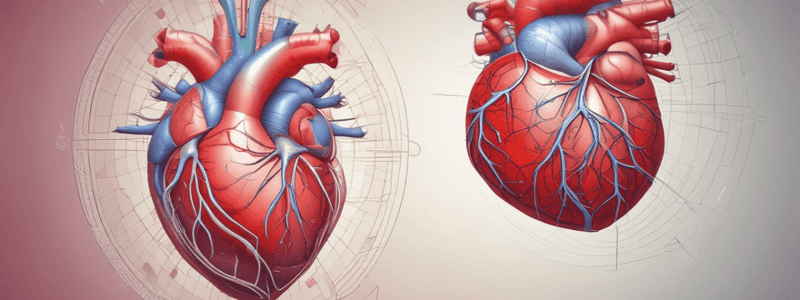Podcast
Questions and Answers
What effect does increased atrial pressure have on ANP secretion?
What effect does increased atrial pressure have on ANP secretion?
- Has no effect on ANP secretion
- Increases ANP secretion (correct)
- Increases parathyroid hormone secretion instead
- Decreases ANP secretion
Which of the following mechanisms is involved in increasing cardiac output during the baroreceptor reflex?
Which of the following mechanisms is involved in increasing cardiac output during the baroreceptor reflex?
- Decreased blood volume
- Increased renal vasodilation
- Decreased sympathetic outflow
- Increased heart rate (correct)
What is the primary role of peripheral chemoreceptors located in the carotid and aortic bodies?
What is the primary role of peripheral chemoreceptors located in the carotid and aortic bodies?
- Regulating heart rate
- Controlling breathing (correct)
- Monitoring blood glucose levels
- Maintaining blood pressure
How does increased PCO2 affect blood pressure regulation?
How does increased PCO2 affect blood pressure regulation?
What is a result of the activation of the sympathetic vasoconstrictor center?
What is a result of the activation of the sympathetic vasoconstrictor center?
Which of the following factors would decrease total peripheral resistance (TPR)?
Which of the following factors would decrease total peripheral resistance (TPR)?
Which component of the Baroreceptor Reflex primarily detects changes in blood pressure?
Which component of the Baroreceptor Reflex primarily detects changes in blood pressure?
How does the Renin-angiotensin-aldosterone system (RAAS) primarily influence blood pressure?
How does the Renin-angiotensin-aldosterone system (RAAS) primarily influence blood pressure?
What is the function of cardiovascular autoregulation in relation to blood pressure?
What is the function of cardiovascular autoregulation in relation to blood pressure?
What is the relationship between pulse pressure and stroke volume?
What is the relationship between pulse pressure and stroke volume?
Which of the following correctly describes mean arterial pressure (MAP)?
Which of the following correctly describes mean arterial pressure (MAP)?
What role do central and peripheral chemoreceptors play in blood pressure regulation?
What role do central and peripheral chemoreceptors play in blood pressure regulation?
What primarily regulates central venous pressure (CVP)?
What primarily regulates central venous pressure (CVP)?
Which of the following factors increases the right atrium pressure?
Which of the following factors increases the right atrium pressure?
What is a key characteristic of pulmonary vascular resistance compared to systemic vascular resistance?
What is a key characteristic of pulmonary vascular resistance compared to systemic vascular resistance?
What happens to the mean arterial pressure when cardiac output increases?
What happens to the mean arterial pressure when cardiac output increases?
How does the body adapt blood flow through the lungs to match ventilation needs?
How does the body adapt blood flow through the lungs to match ventilation needs?
Which system plays a critical role in long-term regulation of blood pressure?
Which system plays a critical role in long-term regulation of blood pressure?
What is the primary role of baroreceptors in the cardiovascular system?
What is the primary role of baroreceptors in the cardiovascular system?
What is the effect of increased large vessel tone throughout the body on venous return?
What is the effect of increased large vessel tone throughout the body on venous return?
Flashcards are hidden until you start studying
Study Notes
Blood Pressure Overview
- Blood pressure varies throughout the cardiovascular system; equal pressures would prevent blood flow.
- Pressure differences drive blood circulation.
Definitions of Blood Pressures
- Systolic Pressure: Highest arterial pressure during a cardiac cycle after the left ventricle ejects blood.
- Diastolic Pressure: Lowest arterial pressure when blood is not ejected during ventricular relaxation.
- Pulse Pressure: Difference between systolic and diastolic pressures; reflects stroke volume.
- Calculated as: Pulse Pressure = Systolic Pressure - Diastolic Pressure.
- Mean Arterial Pressure (MAP): Average pressure during a complete cardiac cycle.
- Calculated as: MAP = Diastolic Pressure + (1/3 * Pulse Pressure).
Factors Influencing Blood Pressure
- Compliance: Relates arterial volume to pressure; arterial pressure depends on blood volume when compliance is constant.
- Increased heart rate, blood volume, and central venous pressure (CVP) elevate MAP.
Baroreceptor Reflex
- Baroreceptors regulate blood pressure by detecting changes and triggering compensatory mechanisms.
Role of the Renin-Angiotensin-Aldosterone System (RAAS)
- RAAS increases blood pressure through vasoconstriction, sodium retention, and fluid volume increase.
Atrial Receptors Influence
- Atrial receptors detect CVP increases, leading to:
- Release of Atrial Natriuretic Peptide (ANP) to decrease blood volume by stimulating renal excretion.
- Inhibition of RAAS, promoting vasodilation.
Chemoreceptors and Blood Pressure
- Central Chemoreceptors: Located in the brainstem; sensitive to changes in PCO2 and PO2; help regulate blood flow and respiratory rate.
- Peripheral Chemoreceptors: Found in carotid and aortic bodies; activated by low oxygen and high carbon dioxide levels; influence heart rate and vascular resistance.
Central Venous Pressure (CVP)
- Represents pressure in the right atrium, influenced by:
- Heart pumping capacity.
- Blood volume and peripheral venous pressure.
Pulmonary Circulation
- Lower pressure in the pulmonary circulation compared to systemic; pulmonary vascular resistance is significantly lower.
- Blood flow through lungs must match ventilation for optimal gas exchange (ventilation-perfusion matching).
Mean Arterial Pressure Regulation
- MAP is regulated through cardiac output (CO) and total peripheral resistance (TPR).
- Formula: MAP = CO x TPR; influenced by various physiological mechanisms.
Studying That Suits You
Use AI to generate personalized quizzes and flashcards to suit your learning preferences.




